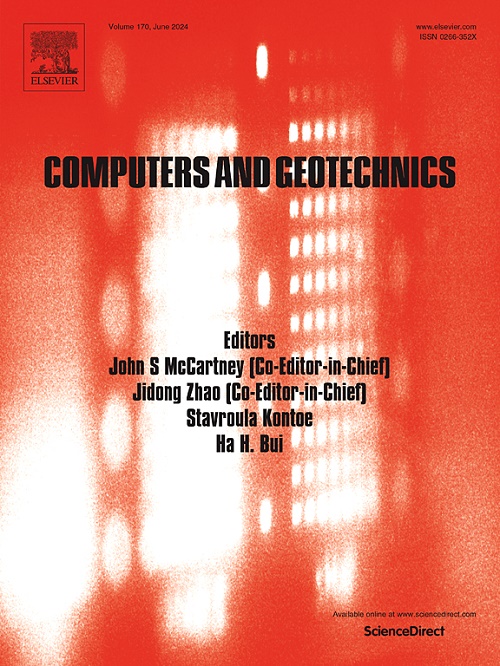基于CFD-DEM的多因素条件下间隙级配土渗流宏微观研究
IF 6.2
1区 工程技术
Q1 COMPUTER SCIENCE, INTERDISCIPLINARY APPLICATIONS
引用次数: 0
摘要
内部侵蚀引起土壤初始微观结构的改变,同时影响物理、水力和机械特性。土壤初始组成对渗流渗流的发生和发展起着至关重要的控制作用。本研究采用控制变量方法建立了不同粒径比、初始细粒含量和粗粒形状的颗粒土模型。采用CFD-DEM方法进行了渗流模拟和微观结构分析。结果表明:在宏观和微观尺度上,粒径比、细粒含量和粗粒形状对累积侵蚀质量、细粒分布、接触结构和机械冗余都有明显的影响。这项数值研究促进了对内部侵蚀机制的基本理解,并为微观力学本构模型的发展提供了信息。此外,对于由粗粒和细粒组成的二元颗粒介质,建议在路堤和大坝建设中使用间隙级配土时,仔细控制粒径比和细粒含量,以提高结构的回弹性和抗内侵蚀能力。本文章由计算机程序翻译,如有差异,请以英文原文为准。
Macro- and micro-scale investigation of suffusion in gap-graded soils under multiple factors using CFD-DEM
Internal erosion induces alterations in the initial microstructure of soils, simultaneously affecting physical, hydraulic, and mechanical properties. The initial soil composition plays a crucial role in governing the initiation and progression of seepage-induced suffusion. This study employs the controlled variable method to develop granular soil models with varying particle size ratios, initial fine particle contents, and coarse particle shapes. Seepage suffusion simulations coupled with microstructural analyses are conducted using the CFD-DEM approach. Results demonstrate that particle size ratio, fine particle content, and coarse particle shape exert distinct influences on cumulative erosion mass, fine particle distribution, contact fabric, and mechanical redundancy at both macroscopic and microscopic scales. This numerical investigation advances the fundamental understanding of internal erosion mechanisms and informs the development of micro-mechanical constitutive models. Furthermore, for binary granular media composed of coarse and fine particles, careful control of the particle size ratio and fine content is recommended when utilizing gap-graded soils in embankment and dam construction to improve structural resilience and resistance to internal erosion.
求助全文
通过发布文献求助,成功后即可免费获取论文全文。
去求助
来源期刊

Computers and Geotechnics
地学-地球科学综合
CiteScore
9.10
自引率
15.10%
发文量
438
审稿时长
45 days
期刊介绍:
The use of computers is firmly established in geotechnical engineering and continues to grow rapidly in both engineering practice and academe. The development of advanced numerical techniques and constitutive modeling, in conjunction with rapid developments in computer hardware, enables problems to be tackled that were unthinkable even a few years ago. Computers and Geotechnics provides an up-to-date reference for engineers and researchers engaged in computer aided analysis and research in geotechnical engineering. The journal is intended for an expeditious dissemination of advanced computer applications across a broad range of geotechnical topics. Contributions on advances in numerical algorithms, computer implementation of new constitutive models and probabilistic methods are especially encouraged.
 求助内容:
求助内容: 应助结果提醒方式:
应助结果提醒方式:


